The Old English Sheepdog, also known as the “Bobtail,” is a distinctive and lovable breed that captures the hearts of dog enthusiasts worldwide. With their shaggy coats, endearing expressions, and playful personalities, these dogs make excellent companions for families and individuals.
This comprehensive guide will delve into the history, distinctive characteristics, grooming and training needs, health considerations, and more to help you determine if the Old English Sheepdog is the right breed for you. So, let’s embark on this exciting journey and explore the world of the Old English Sheepdog together!
Key Takeaways
- The Old English Sheepdog, also known as the Bobtail, is a lovable and lively breed with a distinctive appearance.
- They have a rich history and were initially bred for herding purposes.
- Old English Sheepdogs are known for their shaggy coats, friendly temperament, and playful nature.
- Grooming needs for this breed are extensive, requiring regular brushing and occasional professional grooming.
- Training an Old English Sheepdog requires consistency, positive reinforcement, and early socialization.
- Health considerations include potential hip dysplasia, deafness, and eye problems.
- They thrive in spacious living environments with access to outdoor areas.
- Socialization is essential for Old English Sheepdogs to develop good behavior and prevent shyness.
- Caring for an Old English Sheepdog involves providing mental and physical stimulation.
- If you’re considering adopting an Old English Sheepdog, reputable research breeders, or adopting from a rescue organization.
Old English Sheepdog: A Brief History
The Old English Sheepdog has a fascinating history that dates back several centuries. This breed originated in England and was primarily developed for herding livestock, notably sheep. Their robust build, herding solid instincts, and thick double coats equipped them to endure harsh weather conditions while tending to flocks in the rugged countryside.
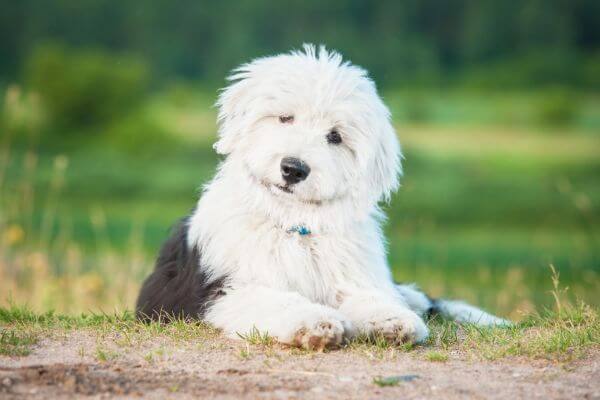
The exact origins of the Old English Sheepdog are unclear. Still, it is believed that they descended from several European herding breeds, such as the Bearded Collie and the Russian Owtchar. These early herding dogs were brought to England by various European traders and were eventually crossed with local herding breeds to create the Old English Sheepdog we know today.
Distinctive Characteristics and Temperament
Distinctive Characteristics
This breed is instantly recognizable by its iconic appearance. Here are some of its distinctive characteristics:
- Double Coat: The breed’s thick double coat protects from the elements with a soft, dense undercoat and a harsh, shaggy outer coat.
- Shaggy Face and Ears: Their expressive face features a prominent forehead, a large black nose, and dark, soulful eyes. Their ears are typically hidden beneath the abundant hair on their heads.
- Bobtail: The Old English Sheepdog’s tail is often docked, giving it a bobbed or shortened appearance. In some countries, tail docking is prohibited or restricted.
- Large and Muscular Build: These dogs have a sturdy and muscular physique, with males typically standing around 22 inches (56 cm) at the shoulder and weighing between 65 and 100 pounds (30 to 45 kg).
Temperament
They are renowned for their friendly and gentle nature, making them excellent family pets. Here are some key traits of their temperament:
- Affectionate: These dogs thrive on human companionship and are known for their devotion to their families. They enjoy being part of household activities and forming strong bonds with their owners.
- Intelligent: Old English Sheepdogs are brilliant and quick learners. They have a herding instinct and excel in various dog sports and activities.
- Playful and Lively: Old English Sheepdogs are active and energetic despite their size. They have a youthful exuberance and love engaging in games and activities that challenge their minds and bodies.
- Good with Children: Because they are often kind and patient with youngsters, they make excellent family pets. They enjoy playing and are frequently protective of their young human friends.
- Sociable: These dogs are generally friendly towards strangers and other animals, thanks to their pleasant nature. Early socialization is crucial to ensure they become well-rounded and confident individuals.
Grooming Needs: Keeping the Shaggy Coat in Check
One of the most distinctive features of this breed is its luxurious, shaggy coat. While it adds to its charm, it requires regular maintenance to keep it looking its best. Here’s what you need to know about grooming an Old English Sheepdog:
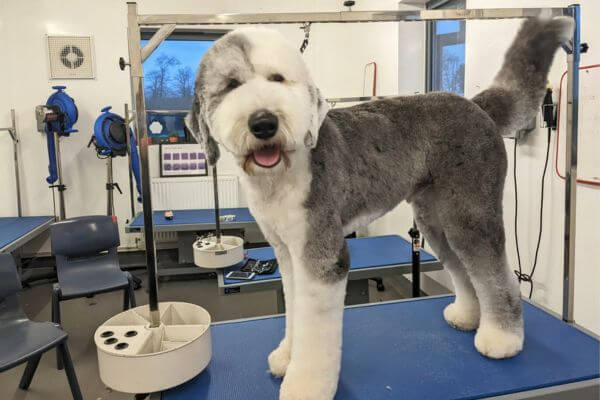
- Coat Care: An Old English Sheepdog’s dense and shaggy coat requires regular brushing to prevent matting and tangling. Aim for daily brushing sessions using a slicker brush or a comb designed for long-haired breeds.
- Bathing and Drying: Bathing should be done when necessary, typically every 6-8 weeks or as your veterinarian recommends. Use a dog-specific shampoo and conditioner to maintain their coat clean and healthy. After bathing, ensure thorough drying because the dense undercoat can take a long time to dry.
- Professional Grooming: Many Old English Sheepdog owners opt for professional grooming services due to high demands. A professional groomer can trim the hair around their face, paws, and tail, ensuring a tidy appearance.
- Ear and Eye Care: Regularly check and clean their ears to prevent infections. Their long hair can trap dirt and moisture, making them prone to ear problems. Additionally, be fit for any discharge, redness, or signs of irritation in their eyes, and consult a veterinarian if needed.
- Paw Care: The fur between their pads should be trimmed to prevent matting and discomfort. Regularly inspect their paws for any signs of injury or foreign objects, and keep their nails cut to a suitable length.
Grooming sessions also serve as valuable bonding time with your Old English Sheepdog, reinforcing your trust and connection with your furry friend.
Training Needs: Nurturing the Intelligent Mind
Old English Sheepdogs are intelligent and eager to please, which makes training a rewarding experience. However, their independent streak can sometimes make them stubborn. Here are some training tips to help you bring out the best in your Old English Sheepdog:
- Start Early: Begin training your Old English Sheepdog as early as possible. The earlier you start, the better your chance of instilling good behavior and manners.
- Positive Reinforcement: Use positive reinforcement techniques, such as treats, praise, and playtime, to motivate and reward your dog for desired behaviors. This breed responds well to positive reinforcement, making it an effective training method.
- Consistency and Patience: Use clear and concise commands in your training approach. Remember to be patient with your dog, as it may take time for them to grasp specific commands or behaviors fully.
- Socialization: Early socialization is crucial for Old English Sheepdogs to become well-rounded and confident dogs. Expose them to various people, animals, sounds, and environments from a young age to prevent shyness or fearfulness.
- Obedience Training: Basic obedience training is essential for every dog, and Old English Sheepdogs are no exception. Teach them commands like sit, stay, come, and leash walking to ensure they become well-behaved and manageable companions.
- Mental Stimulation: In addition to physical exercise, Old English Sheepdogs require mental stimulation to engage their intelligent minds. Provide puzzle toys, interactive games, and training sessions that challenge their problem-solving skills.
Remember, training should always be conducted with positive reinforcement and kindness. Harsh or punitive methods can cause fear or anxiety in your Old English Sheepdog, leading to behavioral issues.
Health Considerations: Ensuring a Healthy and Happy Life
Like all dog breeds, this breed is susceptible to certain health conditions. Understanding these potential health considerations can help you provide the necessary care and early detection of any issues. Here are some common health concerns associated with this breed:
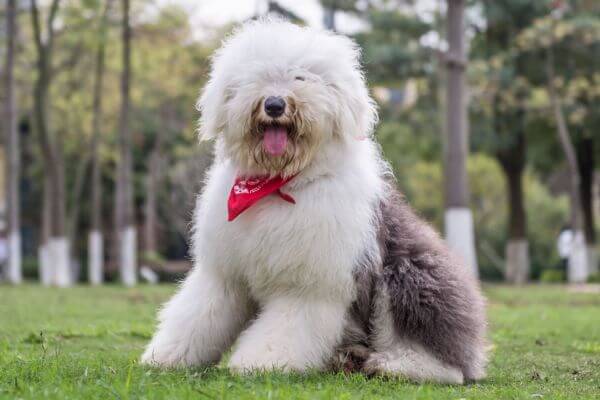
- Hip Dysplasia: Hip dysplasia is a hereditary condition that causes the hip joint to develop abnormally, resulting in joint instability and the possibility of arthritis. Regular activity, a healthy weight, and genetic testing can all help to lower the risk of hip dysplasia.
- Deafness: Congenital deafness in Old English Sheepdogs can affect one or both ears. If you suspect hearing loss in your dog, consult a veterinarian who can perform hearing tests and guide communication methods.
- Eye Problems: In Old English Sheepdogs, progressive retinal atrophy (PRA) and cataracts are common eye conditions. Regular eye examinations by a veterinary ophthalmologist can help detect and manage these conditions early on.
- Bloat: Bloat, or gastric dilation volvulus (GDV), is a potentially fatal condition that mostly affects deep-chested breeds like the Old English Sheepdog. Feeding many small meals throughout the day, avoiding excessive exercise immediately after meals, and utilizing high-feeding bowls can all assist in limiting the incidence of bloat.
- Skin Conditions: The dense coat of Old English Sheepdogs can make them prone to various skin conditions, including allergies, hot spots, and dermatitis. Regular grooming, a balanced diet, and prompt treatment of any skin issues are essential for their skin health.
Routine veterinary check-ups, a balanced diet, regular exercise, and maintaining a healthy weight are vital for the overall well-being of your Old English Sheepdog.
Living Space Consideration: Room to Roam
They are known for their active and lively nature. While they can adapt to various living arrangements, they thrive in spacious environments with access to outdoor areas. Here are some considerations when it comes to providing a suitable living space for your Old English Sheepdog:
- Backyard or Outdoor Space: A secure, fenced-in backyard allows your Old English Sheepdog ample space to roam and play. They like exploring and having the opportunity to expend energy in a safe atmosphere.
- Indoor Living: While Old English Sheepdogs love spending time outdoors, they are indoor dogs at heart. They enjoy being close to their families and should have access to comfortable indoor spaces. Ensure they have a designated area where they can rest and relax.
- Exercise Needs: Regular exercise is crucial for an Old English Sheepdog’s physical and mental well-being. Aim for at least one hour of daily exercise, including walks, runs, playtime, and engaging activities that challenge their minds.
- Climate Considerations: The dense coat of an Old English Sheepdog provides insulation in cold weather, but they can be susceptible to overheating in hot climates. Ensure they have access to shade and fresh water, and avoid exercising during the hottest parts of the day.
Adaptable and adaptable to various living arrangements, Old English Sheepdogs thrive in environments where they can receive the attention, exercise, and mental stimulation they need.
Socialization: Building Confidence and Good Behavior
Early socialization is vital for any dog breed, including the Old English Sheepdog. Exposure to various people, animals, sounds, and environments from a young age helps them develop good behavior, confidence, and adaptability. Here’s how you can ensure proper socialization for your Old English Sheepdog:
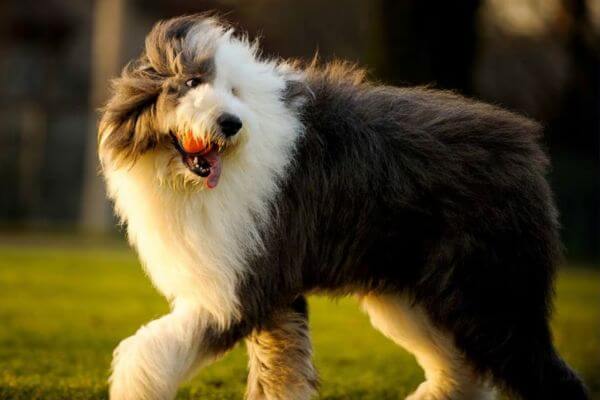
- Puppy Classes: Enroll your Old English Sheepdog in puppy classes, where they can interact with other puppies and learn basic obedience skills. These classes provide a controlled and supervised environment for positive socialization experiences.
- Meeting People: Introduce your Old English Sheepdog to different people, including children, adults, and individuals wearing different types of clothing, such as hats or sunglasses. Encourage gentle interactions and positive experiences with strangers.
- Animal Encounters: Expose your Old English Sheepdog to various animals in a controlled setting, such as other friendly dogs or cats. This helps them learn appropriate social behaviors and prevents fear or aggression toward other animals.
- Handling and Grooming: Regularly handle your Old English Sheepdog’s paws, ears, and mouth, ensuring they are comfortable with grooming activities and veterinary examinations. Start these handling exercises slowly and reward them with treats and praise.
By prioritizing socialization, you can raise a well-adjusted Old English Sheepdog comfortable in different situations and environments.
Caring for Your Old English Sheepdog: Meeting Their Needs
Caring for this breed goes beyond basic needs like food and shelter. Here are some important factors to consider when giving the finest care for your pet:
- Nutrition: Feed your pup a balanced, high-quality diet recommended by your veterinarian. Obesity can be a concern in this breed, so monitor their weight and adjust their food portions accordingly.
- Exercise and Mental Stimulation: Regularly engage your pup and provide mental stimulation through puzzle toys, interactive games, and training sessions. This helps prevent boredom and promotes their overall well-being.
- Regular Veterinary Care: Schedule regular check-ups with a veterinarian to monitor your pup’s health, administer vaccinations, and address any concerns or potential health issues.
- Dental Care: Maintain good oral hygiene by regularly brushing your Old English Sheepdog’s teeth and providing dental chews or toys to promote healthy teeth and gums.
- Love and Attention: Old English Sheepdogs thrive on love, attention, and companionship. Spend quality time with your dog, providing affection, playtime, and opportunities for bonding.
Adopting an Old English Sheepdog: Finding Your Perfect Match
If you’ve decided that this breed is the right breed for you, there are a few options to consider when bringing one into your family:
- Reputable Breeders: Look for reliable breeders who focus on their pets’ health and well-being. Ensure they follow responsible breeding practices, conduct health screenings, and adequately care for their puppies.
- Rescue Organizations: Consider adopting an Old English Sheepdog from a rescue organization or shelter. Many Old English Sheepdogs require loving homes and can make excellent companions.
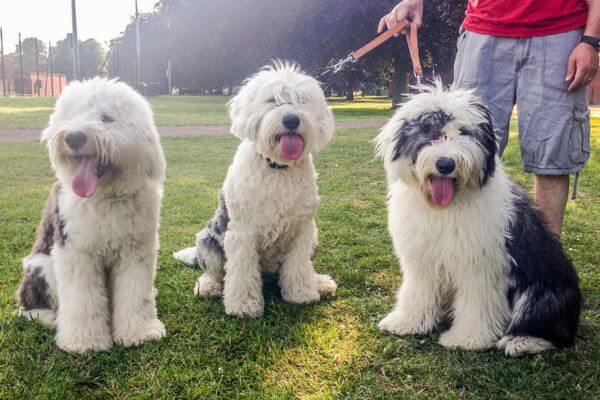
Before adopting, ask questions about the dog’s background, health history, and behavioral considerations. Take the time to meet and interact with the dog to ensure compatibility and establish a bond.
Frequently Asked Questions
Why are they called Old English Sheepdogs?
The name “Old English Sheepdog” reflects the breed’s origins and historical use as a herding dog in England. Their long history and association with sheep herding led to their name, distinguishing them as a breed.
Are Old English Sheepdogs good pets?
They can make excellent pets for the right family. They are popular among families and people looking for a devoted companion due to their pleasant disposition, intellect, and playful demeanor.
What is the purpose of an Old English Sheepdog?
Historically, they were bred to work alongside shepherds, herding and protecting sheep. Today, while still capable of herding, they are primarily kept as companion animals due to their gentle temperament and affectionate nature.
Are Old English Sheepdogs noisy?
They are generally known to be moderately quiet. However, like dogs, they may bark to communicate or express their needs. Training and socialization can help regulate and manage their barking.
How rare are Old English Sheepdogs?
Old English Sheepdogs are not considered rare but less common than other famous breeds. Their distinctive appearance and unique grooming needs may contribute to their relative rarity compared to more mainstream breeds.
Are Old English Sheepdogs good with children?
Yes, they are known to be good with children. They are typically gentle, patient, and protective of their young human companions. However, as with any dog, it is essential to supervise interactions between dogs and children and teach children how to appropriately interact with dogs to ensure everyone’s safety and well-being.
Conclusion
Ah, the Old English Sheepdog – a breed draped in charisma and brimming with affection. As we’ve journeyed through their captivating beauty and endearing nature, it’s evident why these gentle giants have captured so many hearts. But remember, behind their delightful fluff and jovial trot, and they yearn for a forever home, a place where their lovable personalities can shine brightest.
At Bone Voyage Dog Rescue, we’ve seen firsthand the joy these dogs bring. Why let that love be limited to words or pictures? Consider adopting from us and experience the unparalleled bond these magnificent dogs offer.
Let’s turn admiration into action and give an Old English Sheepdog the loving home it deserves. Dive into a world of genuine companionship with Bone Voyage Dog Rescue today. Your fluffy, heartwarming adventure awaits!
